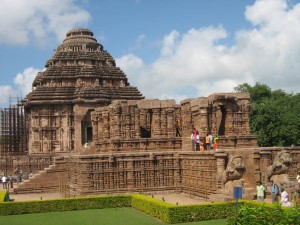About
Understand[edit] Partial view of Konark Sun Temple Konark is also known as Konaditya. The name "Konark" is derived from the words koṇa ("corner") and arka ("Sun"), therefore it literally means "corner of the Sun". It is at north-east of Puri or the Chakrakshetra. The Sun Temple of Konark, often called the Black Pagoda, was constructed in the mid-thirteenth century by Raja Narasinghs Deva I of the Ganga Dynasty and is an ample testament to the artistic glory of the time. It is often considered the best among other temples of its kind and that is saying something when you are talking about the Swarna Tribhuja ("golden triangle") of Odisha which boasts of Jagannath Temple and Lingaraja Temple of Puri and Bhubaneswar respectively. The entire territory lies in the tropics and hence is subject to high temperatures. Legend of Konark[edit] Legend has it that Samba, the king of Krishna and Jambavati entered the bathing chamber of Krishna's wives, and was cursed by Krishna with leprosy. It was decreed that he would be relieved of the curse by worshipping the Sun God on the sea coast north-east of Puri. It is said that the temple was not completed as conceived because the foundation was not strong enough to bear the weight of the heavy dome. As stated in the various stories regarding the temple as well as its construction, the temple possess a huge aura of power. It is believed that this enormous power comes from the two powerful magnets. It is stated that these magnets are used in the construction of the tower. The magnet made the throne of king to hover in the middle of the air. Due to its magnetic effects, vessels passing through the Konark sea were drawn to it, resulting in heavy damage. Other legends state that magnetic effects of the lodestone disturbed ships' compasses so that they did not function correctly. To save their shipping, the Portuguese voyagers took away the lodestone, which was acting as the central stone and keeping all the stones, and the iron columns used to hold them walls together, of the temple wall in balance. Due to its displacement, the temple walls lost their balance and eventually fell down. But there is no record of this occurrence in any historical records, nor is there any record of the existence of such a powerful lodestone at Konark. Architecture of Sun Temple[edit] The Sun Temple is the culmination of Odishan temple architecture and one of the most stunning monuments of religious architecture in the world. The massive structure, now in ruins, sits in solitary splendour surrounded by drifting sand. Today it is located two kilometers from the sea, but originally the ocean came almost up to its base. Until fairly recent times, in fact, the temple was close enough to the shore to be used as a navigational point by European sailors, who referred to it as the 'Black Pagoda'. The Konark Sun Temple belongs to the Central Indian style of Temple architecture, though it does not have tall shikharas of the later temples of Odisha and Central India.
Read more


